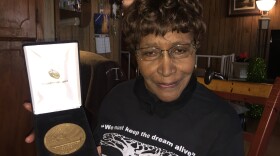Despite the assessment, Steven Carey remains worried. He knows people who’ve lived along Mobile Bay for decades and they see the difference development has made
Alabama Public Radio is turning forty years old. All year long the APR news team is diving into the archive to bring you the best of the best of our coverage. That includes this story from 2015. The APR newsroom spent six months investigating water issues in Alabama, ranging from pollution to a lack of irrigation that proponents claim could make Alabama an agricultural powerhouse. Here’s part of that series from the APR archives.
It’s Sunday afternoon on Lake Guntersville. It’s ninety five degrees outside and Douglas Webster is calling it a day.
“It’s okay. It’s a little slow. Still, the fry…we were finding fry around the piers,” Webster said.
And if you don’t know what a fry is…
“Baby bass,” Webster adds.
Webster’s a bass fisherman. That’s where all the lingo comes from. While Webster secures his bass boat, Braulio Pedroso is just now putting his fishing hook in the water…

“Oh, I just came in about five minutes ago, and they started to bite already. I bet it will be good when the sun goes down a little bit,” he observed.
But Pedroso isn’t interested in catching bass. He’s sitting on a wooden dock with his back to all the boats out on the lake today. Pedroso is fishing for crappies…
“Crappie’s the best,’ Pedroso contends. “They’re good eating, for everybody, the kids when you filet them. It’s white meat and tasty.”
For Braulio Pedroso and Douglas Webster, Lake Guntersville is a fishing hole. For cities like Muscle Shoals, Florence, Decatur and Huntsville, there’s a more basic need and filling that need can get loud. Lake Guntersville is part of the Tennessee River which is a primary source of drinking water in north Alabama. This pumping station draws water from the Tennessee for residents of Huntsville.
“We can go anywhere down to thirty million gallons a day all the way up to sixty or seventy five million gallons, whatever the demand is," says Gary Bailey. He works for Huntsville Utilities. Bailey says demand is so predictable, you can set your watch to it…
“The peak times are early in the morning, and they’re on Monday, Wednesday, and Friday…”

And, Bailey says it’s not due to showers, or toilets flushing--but, rather watering the lawn...
“And, every sprinkler guy sets the sprinklers up for Monday, Wednesday, Friday. And they set up all up for the same time. So, there are our days when we get hit hardest, are Monday, Wednesday, Friday in the morning.”
The Tennessee River takes care of north Alabama. Cities like Tuscaloosa and Birmingham in the central part of the state rely on water from the Black Warrior river basin. A series of locks and dams was put in to create Lake Tuscaloosa. Residents here drink the water from the lake while coal barges carry cargo down the river to the Gulf of Mexico. This arrangement doesn’t make everybody happy…

“Well, the smell is similar to a sewer,” said Penny Behling, who was visiting Tuscaloosa from North Carolina on business…
“The water color is a brown color, and you see…actually, we as stand here talking, we can see the current moving, and we see trash in the water.”
Behling isn’t an environmentalist or a hydrologist. But, her line of work gives her the chance to see bodies of water across the country up close… Behling’s company goes from state to state holding dragon boat races to raise money for local charities. The Tuscaloosa Junior League is sponsoring this event on the Black Warrior. Behling says it’s easy to see when a lake or river is healthy and when it’s not…
“The cleanest water I’ve ever been in and worked a race was in Montana, where you can see all the way to the bottom. It’s so clear, you can see the rocks on the bottom of the lake.”
About ten miles west of Mobile, sits Big Creek Lake. It covers five and a half square miles, and it’s the primary source of drinking water for the city. The process may sound familiar by now. A series of eight turbines pumps around sixty five million gallons of water a day. It travels through sixty inch pipelines roughly four miles to water treatment plants for distribution…
The last stop on our trip around the state is a study in contrasts. Big Creek Lake is the west of Mobile. On the east is Mobile Bay. Seagulls compete for food in the marshy areas near Interstate 10 and U.S. Highway 90 cross the bay. At the north end of the bay, far from the noise of traffic, is the fiove rivers delta. The Mobile, the Spanish, the tensaw, the Apalachee and the Blakeley rivers all empty at one point into Mobile Bay. Fourteen percent of all the fresh water in the nation flows into the bay here.
"Oh, yeah a lot of people don't know that," says Steven Carey. He teaches biology at the University of Mobile.
"They don't realize the size of the drainage basin we have here,” said Carey. “It's the fourth largest, in terms of discharge."
One catch is those five rivers also deliver pollution from three states.
“Oh, north Alabama, parts of Georgia and even in North Mississippi,” says Carey.
But, when it comes to the condition of Mobile Bay, we thought we’d ask a familiar face. Penny Behling and her fleet of dragon boats made their way from the Black Warrior River and Tuscaloosa to a fundraiser here at Five Rivers Delta.
“ When you look down in the water, you can’t see all the way to the bottom, but you can see farther down than you can in the Black Warrior for example.”












